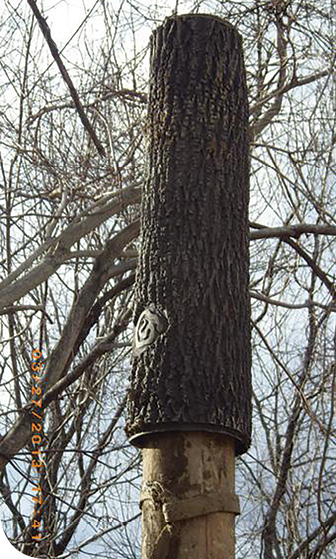
A completed BrandenBark bat structure provides the visual cues that attract bats. Copperhead Consulting’s Adams says the structures require little to no maintenance, are easy to monitor, cost effective, and have been accepted by the U.S. Fish and Wildlife Service as a mitigation tool.
Why bats are attracted to working wind turbines is still something of a mystery. One theory is that they perceive the turning rotors as swaying trees. Their vision is OK but their echolocation has a maximum range of only 20 to 40 ft at best, sometimes causing them to collide with the rotor they don’t see.
Perhaps the best way to protect bat colonies from potential impacts caused by turbines is to encourage roosting at locations far off site. Copperhead Consulting is one company that has had some success in keeping colonies away from fussy neighbors, and although the example here is not a wind farm, the experience may be instructive.
“About nine years ago we did some work for a client that found a colony of Indiana bats in an area they needed to develop, and ideally, wanted the colony to relocate across a particular river,” says Copperhead Director of Energy Services Josh Adams. With the blessing of the U.S. Fish and Wildlife Service, the client set aside a plot of land for the colony and designated it an Indiana Bat Management Area (IBMA). “We began improving its habitat using various methods. We hung artificial bark on snags – dead standing trees – along with what’s called ecoshake shingles. These are small shelters with cues that would likely key on the bat’s visual preference and temperature requirements – all to get the bats to stay in the IBMA. With some success, they started moving into the artificial bark and eco-shake shingles. Once we were able to document successful use, we immediately began researching how to improve the roosts.”
A completed BrandenBark bat structure likely provides the visual cues that attract bats. Copperhead Consulting’s Adams says the structures require little to no maintenance, are easy to monitor, cost effective, and have been accepted by the U.S. Fish and Wildlife Service as a mitigation tool.
Shortly thereafter, a good looking fake tree at a mall caught the eye of one of the naturalists. It was interesting but too big. Could the manufacturer make something smaller, easier to handle? “We worked with the company to tweak the product to meet our needs, such as textures on the backside, and smaller dimensions to ease its handling. After installing the improved design, bats moved in by the hundreds. At last count, 451 bats were roosting in just one shelter on the IBMA,” said Adams. These bat shelters, now called BrandenBark roosts, have been erected in seven states. What’s more, the original colony has stayed in the IBMA, away from the development, for six years.
But like recalcitrant teenagers, the occasional few will go where they should not. “We still have one or two that will occasionally roost on the wrong side of the river. We know we have the same bats using the area, because we have recaptured the same ones year after year, four and five times,” he says.
Adams adds that Indiana bats roost in large colonies, maternity colonies that can number in hundreds and use multiple trees on the landscape. They prefer to roost in groups but the individuals generally switch roosts every two-three days. The artificial structures seem to appeal to several bat species with the right temperature and visual cues.

The tiny radio transmitter allows tracking the flight pattern and location of diurnal roosts of bats.
Currently six species of bats have been documented using the roosts. “Eastern tri-color bats, little brown bats, evening bats, big brown bats, and northern long-eared bats–now federally threatened–have all been found roosting in our structures,” says Adams.
He adds that his consultancy has conducted presence-absence surveys on wind facilities in Illinois, Indiana, Mossuri, Tennessee, and is currently working on developments in Virginia. “Every site presents its own unique challenges and being able to come up with creative solutions to complex problems allows developers more flexibility in moving forward with project plans,” he says.
His message to the wind industry is to, “Coordinate with the agencies early and with help of knowledgeable consultants. Being transparent and upfront about how you are going to approach any issues that may arise will eliminate delays and cost increases later on in the process,” he says.
Filed Under: News





